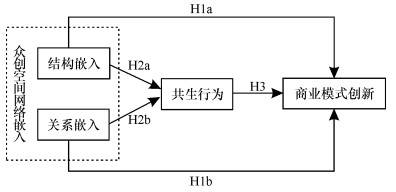The Public Entrepreneurship Space Network Embedding and Business Model Innovation: The Mediating Role of Symbiosis
-
摘要: 众创空间是开放式经济背景下的新型创新创业服务平台。创业企业嵌入到众创空间中,能够更有效地促进其商业模式创新。以网络嵌入和共生理论为理论基础,研究众创空间网络嵌入对创业企业商业模式创新的影响机制。基于北京中关村创业大街、杭州梦想小镇等知名众创空间中181家创业企业的问卷调查数据,采用多元回归模型进行实证检验,发现众创空间网络嵌入与创业企业商业模式创新有显著正相关关系,且共生行为在其中发挥中介作用。Abstract: The public entrepreneurship space is a new type of innovative and entrepreneurial service platform emerging in the context of open economy. Start-ups embedded in the public entrepreneurship space can promote its business model innovation more effectively. Based on the theory of network embedding and symbiosis, this research explores the impact mechanism of the public entrepreneurship space on the innovation of business models of entrepreneurial enterprises. Based on the questionnaire data of 181 start-ups in Zhongguancun Maker Street and Hangzhou Dream Town, tested with multiple regression models, the following conclusions are drawn: the public entrepreneurship space network embedding has a positive impact on start-ups' business model innovation; symbiotic behavior plays a mediating role.
-
Key words:
- public entrepreneurship space /
- network embedding /
- business model /
- innovation /
- symbiotic behavior /
- start-ups
-
表 1 验证性因素分析结果
χ2 Df χ2/Df RMSEA RMR CFI TLI 零模型(Null model) 930.042 299 3.111 0.108 0.259 0 0.792 0.774 四因子模型 482.209 284 1.698 0.062 0.047 5 0.935 0.925 三因子模型 636.953 287 2.219 0.082 0.063 7 0.885 0.869 二因子模型 639.445 289 2.213 0.082 0.060 9 0.884 0.870 单因子模型 836.138 290 2.883 0.102 0.080 3 0.820 0.798 注:零模型中,所有测量项目之间没有关系;三因子模型中,将共生行为与商业模式创新并为一个潜在因子;二因子模型中,将众创空间结构嵌入、众创空间关系嵌入与共生行为并为一个潜在因子;单因子模型中,将所有项目归属于同一个潜在因子 表 2 相关性分析表
变量 (1) (2) (3) (4) (5) (6) (7) (8) (9) 性别 1 年龄 -0.11 1 教育程度 0.10 0.08 1 企业成立年限 -0.11 0.12 -0.13 1 企业规模 -0.11 0.04 -0.19** 0.66** 1 众创空间结构嵌入 -0.05 0.10 -0.20** 0.34** 0.33** 1 众创空间关系嵌入 0.04 0.05 -0.15* 0.19* 0.16* 0.61** 1 共生行为 0.11 -0.04 -0.06 0.10 0.17* 0.43** 0.48** 1 商业模式创新 0.01 -0.04 -0.09 0.03 0.16* 0.48** 0.51** 0.59** 1 平均值 1.46 3.13 4.34 3.43 2.74 4.75 4.83 4.44 4.69 标准差 0.50 0.91 0.52 1.77 1.19 1.07 1.07 0.10 0.99 注:**表示在0.01水平上显著;*表示在0.05水平上显著。下表同 表 3 层级回归统计结果

共生行为 商业模式创新 M1 M2 M3 M4 M5 M6 控制变量 性别 0.13 0.09 0.03 -0.00 -0.04 -0.04 年龄 -0.03 -0.07 -0.03 -0.07 -0.01 -0.04 教育程度 -0.03 0.05 -0.06 0.03 -0.04 0.01 企业成立年限 -0.00 -0.10 -0.14 -0.25 -0.14 -0.21 企业规模 0.18 0.13 0.25 0.18 0.14 0.13 自变量 众创空间结构嵌入 0.23** 0.30** 0.21** 众创空间关系嵌入 0.34** 0.35** 0.21** 中介变量 共生行为 0.58** 0.41** R2 0.05 0.28 0.04 0.34 0.37 0.46 ΔR2 0.05 0.23 0.04 0.30 0.33 0.12 F 1.76 9.76** 1.62 12.92** 16.92** 18.42** ΔF 1.76 28.39** 1.62 39.39** 89.37** 37.73** -
[1] 罗兴武, 项国鹏, 宁鹏, 等. 商业模式创新如何影响新创企业绩效?——合法性及政策导向的作用[J]. 科学学研究, 2017(7): 1073-1084. doi: 10.3969/j.issn.1003-2053.2017.07.013 [2] CHESCROUGH H. Business model innovation: opportunities and barriers[J]. Long Range Planning, 2010, 43(2): 354-363. http://www.sciencedirect.com/science/article/pii/S0024630109000569 [3] 吴晓波, 赵子溢. 商业模式创新的前因问题: 研究综述与展望[J]. 外国经济与管理, 2017(1): 114-127. https://www.cnki.com.cn/Article/CJFDTOTAL-WGJG201701009.htm [4] 李靖华, 黄继生. 网络嵌入、创新合法性与突破性创新的资源获取[J]. 科研管理, 2017(4): 10-18. https://www.cnki.com.cn/Article/CJFDTOTAL-KYGL201704002.htm [5] 张春雨, 郭韬, 刘洪德. 网络嵌入对技术创业企业商业模式创新的影响[J]. 科学学研究, 2018(1): 167-175. doi: 10.3969/j.issn.1003-2053.2018.01.019 [6] HUNG J, LI M, MAO L, et al. The impact of network embeddedness on radical innovation performance-intermediators of innovation legitimacy and resource acquisition[J]. International Journal of Technology Policy & Management, 2017, 17(3): 220-239. http://www.researchgate.net/publication/319621616_The_impact_of_network_embeddedness_on_radical_innovation_performance_-_Intermediators_of_innovation_legitimacy_and_resource_acquisition [7] 赵志耘, 杨朝峰. 创新范式的转变: 从独立创新到共生创新[J]. 中国软科学, 2015(11): 155-160. doi: 10.3969/j.issn.1002-9753.2015.11.015 [8] GRANOVETTER M. Economic action and social structure: the problem of embeddedness[J]. American Journal of Sociology, 1985, 91(3): 481-510. doi: 10.1086/228311 [9] BAUM J R, LOCKE E A, SMITH K G. A multidimensional model of venture growth[J]. Academy of Management Journal, 2001, 44(2): 292-303. http://www.researchgate.net/publication/324986022_A_Multidimensional_Model_of_Venture_Growth [10] WASTON J. Modeling the relationship between networking and firm performance[J]. Journal of Business Venturing, 2007, 22(6): 852-874. doi: 10.1016/j.jbusvent.2006.08.001 [11] 彭学兵, 王乐, 刘玥伶, 等. 创业网络、效果推理型创业资源整合与新创企业绩效关系研究[J]. 科学学与科学技术管理, 2017(6): 157-170. https://www.cnki.com.cn/Article/CJFDTOTAL-KXXG201706014.htm [12] JOHNSON M W, CHRISTENSEN C M. Reinventing your business model[J]. Harvard Business Review, 2008, 35(12): 52-60. http://search.ebscohost.com/login.aspx?direct=true&db=buh&AN=35386627&site=ehost-live [13] APAK S, VAYVAY Ö, FEYZIOǦLU O. A decision making model for the evaluation of supply chain execution and management systems[J]. International Journal of Computational Intelligence Systems, 2013, 6(2): 293-306. doi: 10.1080/18756891.2013.769767 [14] OSTERWALDER A, PIGNEUR Y, TUCCI C L. Clarifying business models: origins, present, and future of the concept[J]. Communications of the Association for Information Systems, 1998, 16(16): 751-775. http://www.researchgate.net/publication/37426694_clarifying_business_models_origins_present_and_future_of_the_concept [15] ZOTT C, AMIT R. Business model design and the performance of entrepreneurial firms[J]. Organization Science, 2007, 8(2): 181-199. http://www.emeraldinsight.com/servlet/linkout?suffix=b55&dbid=16&doi=10.1108%2FCMS-03-2013-0050&key=10.1287%2Forsc.1060.0232 [16] 罗兴武, 刘洋, 项国鹏, 等. 中国转型经济情境下的商业模式创新: 主题设计与量表开发[J]. 外国经济与管理, 2018(1): 33-49. https://www.cnki.com.cn/Article/CJFDTOTAL-WGJG201801003.htm [17] ZOTT C, HUY Q N. How entrepreneurs use symbolic management to acquire resources[J]. Administrative Science Quarterly, 2007, 52(1): 70-105. doi: 10.2189/asqu.52.1.70 [18] VELU C. Business model innovation and third-party alliance on the survival of new firms[J]. Technovation, 2015, 35: 1-11. doi: 10.1016/j.technovation.2014.09.007 [19] CHESBROUGH H, ROSENBLOOM R S. The role of the business model in capturing value from innovation: evidence from Xerox corporation's technology spin-off companies[J]. Social Science Electronic Publishing, 2002, 11(3): 529-555. http://www.emeraldinsight.com/servlet/linkout?suffix=b9&dbid=16&doi=10.1108%2F17471111211272129&key=10.1093%2Ficc%2F11.3.529 [20] 葛和平, 吴福象. 垂直专业化、核心技术创新与自主品牌创建——基于产业集群中我国本土企业创新行为视角[J]. 济南大学学报, 2017(3): 102-117. doi: 10.3969/j.issn.1671-3842.2017.03.015 [21] 袁纯清. 共生理论: 兼并小型经济[M]. 北京: 经济科学出版社, 1998. [22] 叶斌, 陈丽玉. 区域创新网络的共生演化仿真研究[J]. 中国软科学, 2015(4): 86-94. doi: 10.3969/j.issn.1002-9753.2015.04.010 [23] 袁纯清. 共生理论及其对小型经济的应用研究(上)[J]. 改革, 1998(2): 100-104. https://www.cnki.com.cn/Article/CJFDTOTAL-REFO802.018.htm [24] 林少疆, 徐彬, 陈佳莹. 企业创新网络结构嵌入性对协同创新能力影响的实证研究——共生行为的中介作用[J]. 软科学, 2016(6): 16-19. https://www.cnki.com.cn/Article/CJFDTOTAL-XUXI201606004.htm [25] 陈佳莹, 林少疆. 企业创新网络关系特征对技术创新绩效的影响路径[J]. 统计与决策, 2014(2): 186-188. https://www.cnki.com.cn/Article/CJFDTOTAL-TJJC201402055.htm [26] KUGOT B, ZANDER U. Knowledge of the firm, combinative capabilities, and the replication of technology[J]. Organization Science, 1992, 3(3): 383-397. doi: 10.1287/orsc.3.3.383 [27] 张玉利, 杨俊, 任兵. 社会资本、先前经验与创业机会——一个交互效应模型及其启示[J]. 管理世界, 2008(7): 91-102. https://www.cnki.com.cn/Article/CJFDTOTAL-GLSJ200807012.htm [28] BELL G G. Clusters, networks, and firm innovativeness[J]. Strategic Management Journal, 2010, 26(3): 287-295. http://www.emeraldinsight.com/servlet/linkout?suffix=b9&dbid=16&doi=10.1108%2F01443331011072271&key=10.1002%2Fsmj.448 [29] JONES G R, GEORGE J M. The experience and evolution of trust: implications for cooperation and teamwork[J]. Academy of Management Review, 1998, 23(3): 531-546. doi: 10.5465/amr.1998.926625 [30] AHUJA G. Collaboration networks, structural holes, and innovation: a longitudinal study[J]. Administrative Science Quarterly, 2000, 45(3): 425-455. doi: 10.2307/2667105 [31] 赵宇, 王庆金. 文化创意产业技术创新战略联盟系统动力学分析[J]. 理论学刊, 2017(6): 95-100. https://www.cnki.com.cn/Article/CJFDTOTAL-LLSJ201706013.htm [32] HAUNSCHILD P R, MIMER A S. Modes of interorganizational imitation: the effects of outcome salience and uncertainty[J]. Administrative Science Quarterly, 1997, 42(3): 472-500. doi: 10.2307/2393735 -





 下载:
下载:

